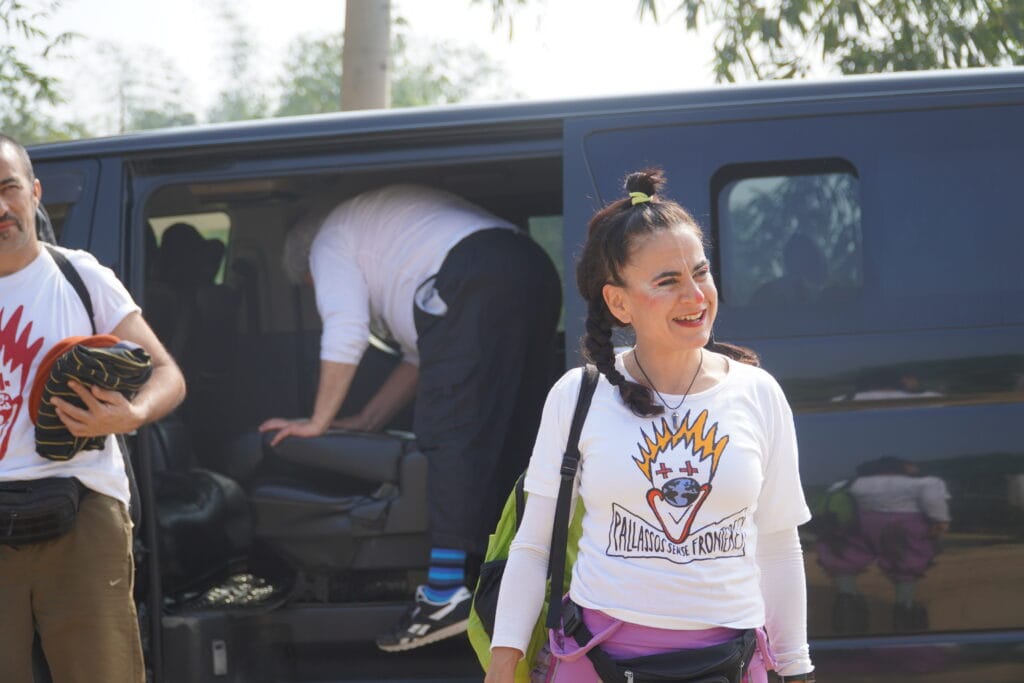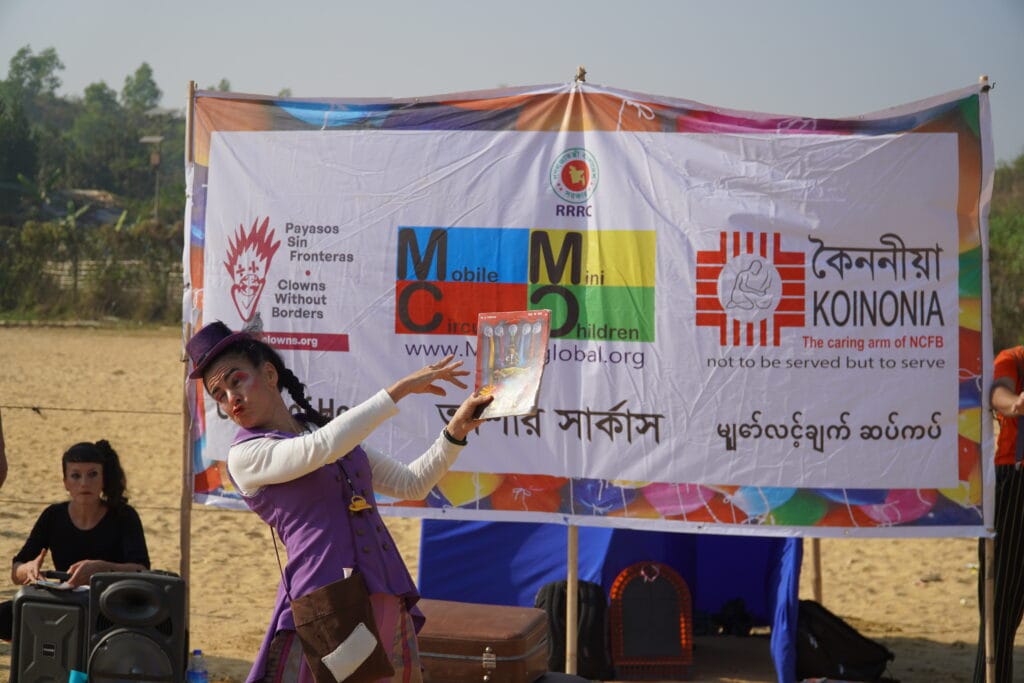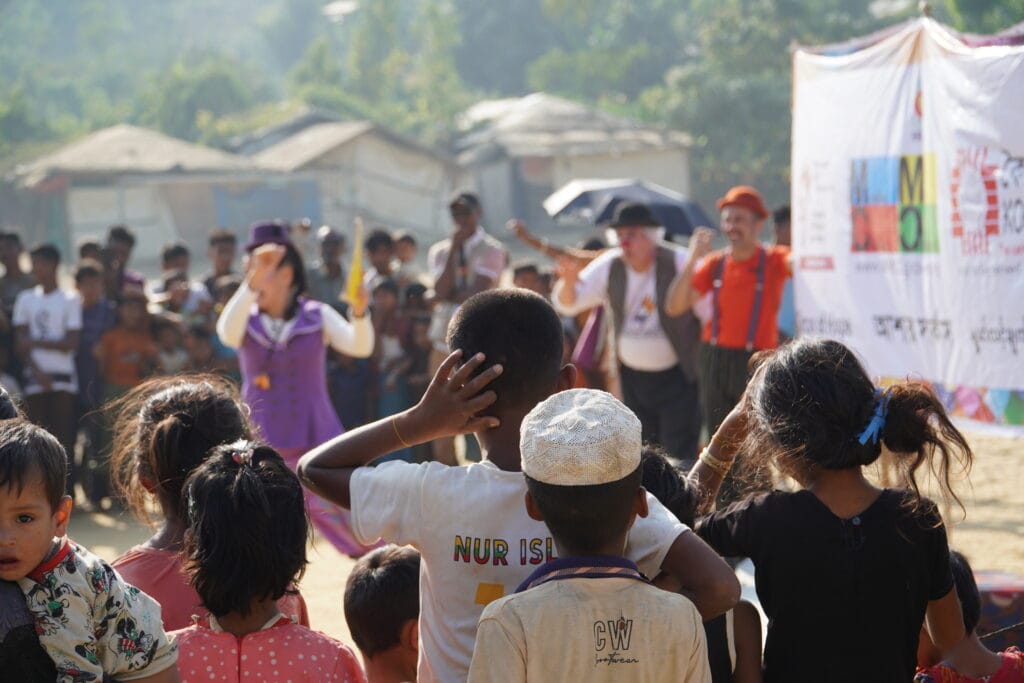Clowns Without Borders in Bangladesh, Rohingya Community Refugee Camps
In this article, the artist Maite Esteban explains her first experience as an artist in an expedition with Clowns Without Borders, carried out at the beginning of this year 2025. The union with the companions, the expectations she had, the reaction of the spectators, and a whole host of mixed feelings that have taught her, as well as excited her.
—
Going through a Clowns Without Borders expedition pushes you to examine yourself and establish a rigid and harmonious order of priorities. You turn your vision towards that other side to which we do not belong, but of which we are a part. You look up from the square meters that surround you and seem to biasedly describe the world.
And you look… You look carefully at where you are going, where that reality exists not only real, but sharply, overwhelmingly sharp.
Immediately you must begin to let go of thoughts, worries, worries, sorrows of your day to day life, and above all, you stop waiting for things to happen. You activate your 5 senses in pursuit of that destiny. You review your tools, your knowledge. You make an exhaustive sift of what you will take and what you will leave out of your physical and mental suitcase. A suitcase that, while you pack it, also reflects everything you have to leave in Spain about myself. In this, my first expedition with Clowns without Borders, I proved it.
Under the premise that defines it, apparently simplistic, “we are going to make shows for children to laugh”, you begin to discover and unravel the deep, vital and revolutionary nature of the subject.
We went to Bangladesh, to the refugee camps of the Rohingya community, with Donald, Marina and Foncu. I was fortunate to travel with the dream team, it must be said.
It is difficult to summarize in a single writing the whole experience and especially the feeling that we were experiencing from the first conversations, planning, ideas and strategies that we were coming up with during the weeks prior to the trip. The arrival and first performances, the relationships we were forging with the locals, the degree of connection and understanding with the monitors with whom we shared each day both in the shows and in the workshops… And of course, the public.
I believe that the human factor in the group was the engine and fuel of this expedition. There were 4 of us, but we functioned as 1. We were able to expose our strengths and weaknesses without shame or embarrassment, in order to offer and give the best of each one of us. Holding each other up and supporting each other when necessary. Adjusting ourselves and reading every day what, where and how we could improve that amalgam.
Once in the field, it was necessary to be efficient, to be clear and to know what everyone had to do.
There was little time to react, restructure and execute many times, and the trust we had in each other generated great confidence. With few words and a lot of action, everything was done.
But back to what is important, what is primordial, the bastion of PSF and what we were… “we are going to do shows to make children laugh”.
Why is it so important?
Because for 30 years clowns and clowns have been visiting remote places in this world for this purpose?
In my opinion, because it’s necessary. Because when your reality is so overwhelming that you can’t think of much more than living another day, you stop laughing.
Laughter is a weapon of mass construction. At the neuronal level, the laughter activates the brain, stimulates muscles and organs, and releases chemicals that generate well-being and a sense of happiness. On a social level, it helps socialization and bonding.
Laughter has a component that is perennial, that lasts and repeats itself.
As Paula Castro, Psychologist at the Psychiatry Department of the Hospital Universitario Astral states, “when we laugh, we experience a feeling of joy that usually remains in our body for a while. It is very common that after laughing out loud, a smile remains on our face, even though the funny episode is over. It is also frequent that a laugh triggers new laughter, linked to the same situation, by the mere fact of remembering the reason that triggered the laughter”.
At each performance, we were able to verify these concepts in a factual way. When we arrived at the performance area, people were usually already waiting, distant. The expectation was relative, since many had not seen any show. It was more a mixture of curiosity and distrust. Curiosity and distrust that varied in degree and motive depending on whether it came from a boy or girl, a woman or an adult man.
But they were always, always there. Filling the place on all sides. You could sense that there was great interest and eagerness for something to happen. A whole community wanting to see what these four oddly dressed people were going to do.
And things began to happen. Things that challenged them, that amazed them, that raised questions. Things they had never seen before and things that made them laugh. That’s where the magic was, that’s where it all began.
Laughter as a collective act took force and magnitude in that context that went beyond the rational and logical. Everyone experiencing a sense of wellbeing, of common union. That is glory.
At the end of the shows, that distance, that distrust or fear, had disappeared. Now everything was hustle and bustle, joy and movement. Looks had changed and bodies had relaxed. Boys and girls crowded around us, wanting to extend that feeling and bonding that we had experienced when we arrived. we had created during the show. They wanted to touch us, to look into each other’s eyes. That, for a second, we could see them…
Laughter is a radical change that lasts over time. That is its power.
Maité, Bangladesh 2025.



